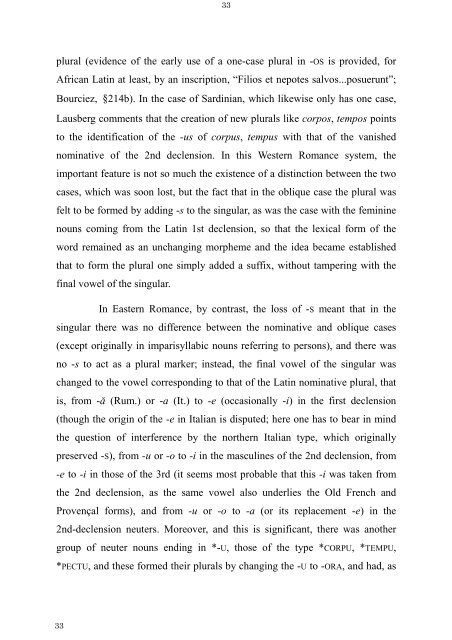The Latin Neuter Plurals in Romance - Page ON
The Latin Neuter Plurals in Romance - Page ON
The Latin Neuter Plurals in Romance - Page ON
You also want an ePaper? Increase the reach of your titles
YUMPU automatically turns print PDFs into web optimized ePapers that Google loves.
33<br />
33<br />
plural (evidence of the early use of a one-case plural <strong>in</strong> -OS is provided, for<br />
African <strong>Lat<strong>in</strong></strong> at least, by an <strong>in</strong>scription, “Filios et nepotes salvos...posuerunt”;<br />
Bourciez, §214b). In the case of Sard<strong>in</strong>ian, which likewise only has one case,<br />
Lausberg comments that the creation of new plurals like corpos, tempos po<strong>in</strong>ts<br />
to the identification of the -us of corpus, tempus with that of the vanished<br />
nom<strong>in</strong>ative of the 2nd declension. In this Western <strong>Romance</strong> system, the<br />
important feature is not so much the existence of a dist<strong>in</strong>ction between the two<br />
cases, which was soon lost, but the fact that <strong>in</strong> the oblique case the plural was<br />
felt to be formed by add<strong>in</strong>g -s to the s<strong>in</strong>gular, as was the case with the fem<strong>in</strong><strong>in</strong>e<br />
nouns com<strong>in</strong>g from the <strong>Lat<strong>in</strong></strong> 1st declension, so that the lexical form of the<br />
word rema<strong>in</strong>ed as an unchang<strong>in</strong>g morpheme and the idea became established<br />
that to form the plural one simply added a suffix, without tamper<strong>in</strong>g with the<br />
f<strong>in</strong>al vowel of the s<strong>in</strong>gular.<br />
In Eastern <strong>Romance</strong>, by contrast, the loss of -S meant that <strong>in</strong> the<br />
s<strong>in</strong>gular there was no difference between the nom<strong>in</strong>ative and oblique cases<br />
(except orig<strong>in</strong>ally <strong>in</strong> imparisyllabic nouns referr<strong>in</strong>g to persons), and there was<br />
no -s to act as a plural marker; <strong>in</strong>stead, the f<strong>in</strong>al vowel of the s<strong>in</strong>gular was<br />
changed to the vowel correspond<strong>in</strong>g to that of the <strong>Lat<strong>in</strong></strong> nom<strong>in</strong>ative plural, that<br />
is, from -ă (Rum.) or -a (It.) to -e (occasionally -i) <strong>in</strong> the first declension<br />
(though the orig<strong>in</strong> of the -e <strong>in</strong> Italian is disputed; here one has to bear <strong>in</strong> m<strong>in</strong>d<br />
the question of <strong>in</strong>terference by the northern Italian type, which orig<strong>in</strong>ally<br />
preserved -S), from -u or -o to -i <strong>in</strong> the mascul<strong>in</strong>es of the 2nd declension, from<br />
-e to -i <strong>in</strong> those of the 3rd (it seems most probable that this -i was taken from<br />
the 2nd declension, as the same vowel also underlies the Old French and<br />
Provençal forms), and from -u or -o to -a (or its replacement -e) <strong>in</strong> the<br />
2nd-declension neuters. Moreover, and this is significant, there was another<br />
group of neuter nouns end<strong>in</strong>g <strong>in</strong> *-U, those of the type *CORPU, *TEMPU,<br />
*PECTU, and these formed their plurals by chang<strong>in</strong>g the -U to -ORA, and had, as









